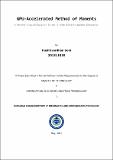Please use this identifier to cite or link to this item:
http://drsr.daiict.ac.in//handle/123456789/544| Title: | GPU-accelerated method of moments |
| Authors: | Zaveri, Mazad S. Soni, Pushtivardhan |
| Keywords: | Algorithms Methods Algorithms Usage Algorithms Analysis Algorithm Computer subject Methods Topical scope Usage Topical scope Analysis Topical scope Earth sciences |
| Issue Date: | 2015 |
| Publisher: | Dhirubhai Ambani Institute of Information and Communication Technology |
| Citation: | Soni, Pushtivardhan (2015). GPU-accelerated method of moments. Dhirubhai Ambani Institute of Information and Communication Technology, 67 p. (Acc.No: T00507) |
| Abstract: | This work considers the use of commodity graphics processing units (GPUs) for accelerating run-time critical phase of method of moments (MoM) which is a widely used computational electromagnetic (CEM) technique for solving electromagnetic problems governed by an electric field integral equation (EFIE), and ideally suited for radiation and scattering problems. To this end, scattering analysis of metallic bodies with arbitrary shape using standard Rao-Wilton-Glisson (RWG) basis and weighting functions which is a good tradeoff between accuracy and complexity, is considered for the serial and parallel implementations. Among the phases of MoM—assembling impedance matrix and excitation vector, and solving matrix equation—impedance matrix assembly is the most compute intensive phase, and involves massive data-based parallelism; computation of each matrix element requires execution of a common program with unique data set. Therefore the impedance matrix assembly phase is subjected to the GPU acceleration using CUDA that supports single instruction, multiple data (SIMD) paradigm. The results computed shows a good agreement with the reference values computed with commercial software package such as FEKO. From the performance viewpoint, the GPU-based implementation shows a significant speedups over the CPU-only implementation. The linear growth of speedup with respect to number of CUDA threads used to compute matrix element conforms the scalability of the implementation, and indicates the feasibility of greater speedups for larger problems. The peak speedup for the impedance matrix assembly phase of MoM was measured to be about 30 that turn up about 4× faster execution when considering total MoM solution process for the problem and hardware considered. In addition, the comprehensive treatment of the scattering problem in functional analysis framework and the detailed implementation of MoM make this work useful for developing other accelerated implementations of other computational electromagnetic (CEM) methods (i.e., FDTD, FEM). |
| URI: | http://drsr.daiict.ac.in/handle/123456789/544 |
| Appears in Collections: | M Tech Dissertations |
Files in This Item:
| File | Description | Size | Format | |
|---|---|---|---|---|
| 201311010.pdf Restricted Access | 2.63 MB | Adobe PDF |  View/Open Request a copy |
Items in DSpace are protected by copyright, with all rights reserved, unless otherwise indicated.
